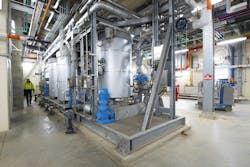The Clinton River WRRF Biosolids Handling & Septage Receiving Facility
Cost: $41,162,000
Location: North Opdyke, Pontiac, Michigan
Year: 2021-12-21
Size: 25.69 gpm
Owner: Oakland County & Oakland County Water Resources Commissioner’s Office
Designers: Oakland County Water Resources Commissioner’s Office
CDM Smith Michigan Inc.
Tooles Contracting Group LLC
Contractor: CDM Smith Michigan Inc.
Tooles Contracting Group LLC
Located in North Opdyke, Pontiac, Michigan, The Clinton River Water Resource Recovery Biosolids Handling and Septage Receiving Facility project focused on the construction of a new thermal hydrolysis pretreatment (THP) system. Additionally, the project prioritized sludge dewatering system improvements, expansion and improvement of the existing dewatered biosolids storage facility, and construction of a new septage receiving facility.
The THP system is a process that involves conditioning of the sludge under high heat prior to anaerobic digestion, resulting in a more easily digested sludge and Class A Expectational Biosolids.
“What we’re trying to do here is we are creating a much, much more efficient way of treating all of these systems, our solids, out of our wastewater,” said Jim Nash, Oakland County Michigan water resources commissioner. “We are basically using what would be generally considered giant pressure cookers to break down the cell wall before it goes to anaerobic digestion, which makes it to be digested and solid about four or five times more efficient as before.”
The team worked to rebuild four separate aspects of the biosolids project: a septage receiving facility; a digester gas membrane storage dome; a covered biosolids storage pad; and the biosolids handling building.
The Septage Receiving Facility is a new masonry building housing septage processing equipment, pumps, electrical equipment, instrumentation and controls. A 60,000‐gallon underground, concrete tank stores highly organic and inert material received at the plant. In addition to providing an alternative revenue source for the water resources commissioner’s operations, the facility provides a discharge location for nearby communities and septage haulers, improving quality of life, achieving regulatory standards, and reusing the material.
The digester gas membrane storage dome, which uses existing primary and secondary digesters that were upgraded to process pretreated THP sludge, was another important aspect. This included new pump mixing systems to optimize digestion and the addition of a flexible membrane cover on the secondary digester to store biogas prior to reuse.
Third was the biosolids storage pad, a 20,400 square foot concrete storage pad with a standing seam roof keeps the dewatered biosolids dry, protected from inclement weather and ready for land application and distribution. The storage facility includes enclosed conveyors and a truck scale to efficiently manage the product prior to beneficial reuse.
Lastly, the biosolids handling building is a precast paneled, two‐story, 15,800 square foot building. It houses multiple sludge pumps, sludge screening equipment, pre‐THP and post‐digestion biosolids dewatering centrifuges, the THP train, steam boilers, polymer storage and feed, electrical equipment, and instrumentation. In conjunction with the digesters, this facility generates quality biosolids for storage.
“This is something that will have a huge payback, because first of all, we’re not going to be land-filling waste anymore,” Nash said. “And we’re going to be producing Grade A fertilizer that can be used in landscaping, that can be used in any way people want to use it and that is perfectly safe.”
A major challenge for this project was odor. The digesters were shut down for approximately one year per the construction requirements, and during this time frame the team had to dewater raw sludge and landfill it, resulting in an unpleasant odor.
Ultimately, the completion of this project would in fact reduce odors emitted from the facility, reduce the facility’s carbon footprint, and reduce the volume of biosolids by 20% and disposal costs by 50%. The facility’s dependence on natural gas was lessened with the use of methane generated from anaerobic digesters, as well.
Project Year: 2021-12-21Contractor: CDM Smith Michigan Inc. Tooles Contracting Group LLCDesigners: Oakland County Water Resources Commissioner’s Office CDM Smith Michigan Inc. Tooles Contracting Group LLCOwner: Oakland County & Oakland County Water Resources Commissioner’s OfficeLocation: North Opdyke, Pontiac, MichiganCost: $41,162,000Size: 25.69 gpm